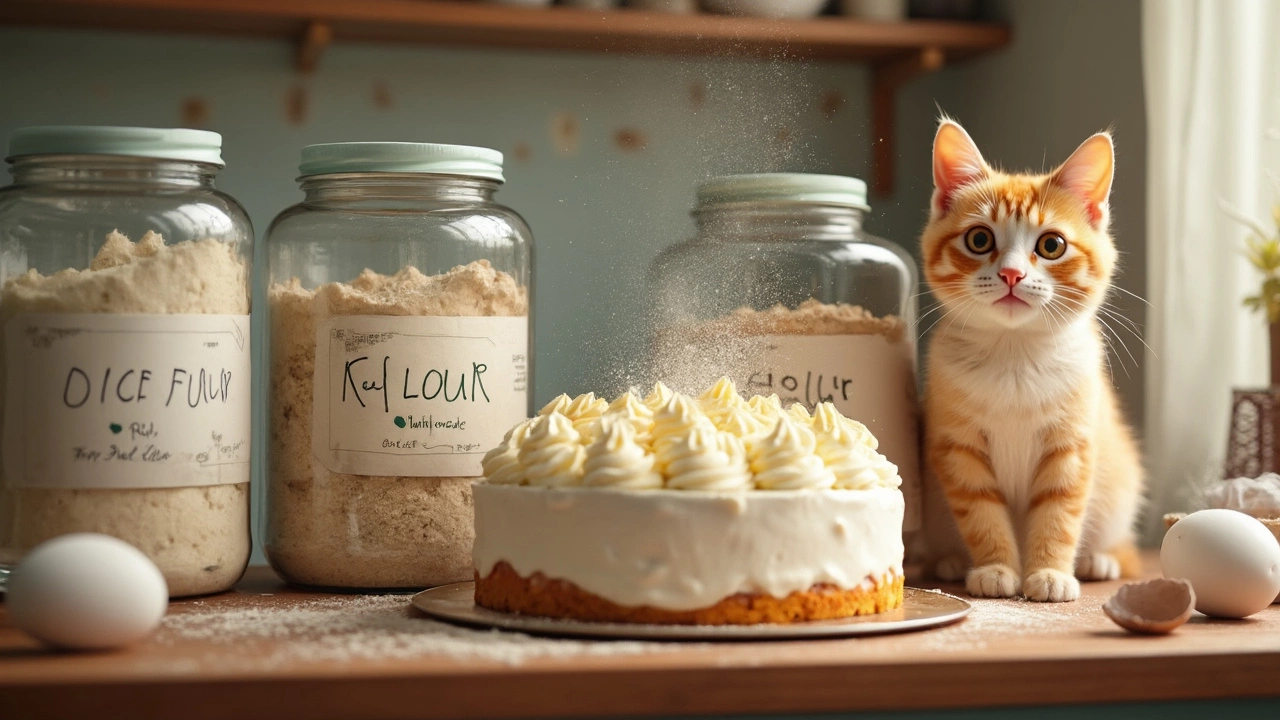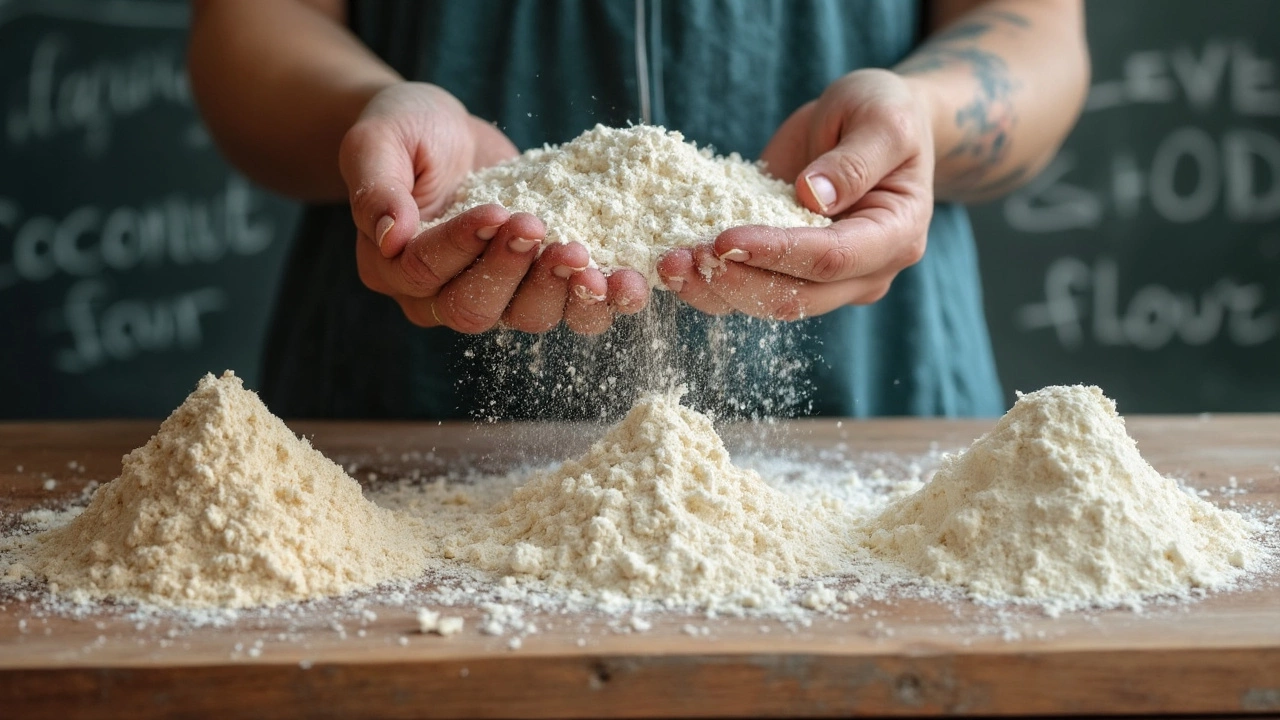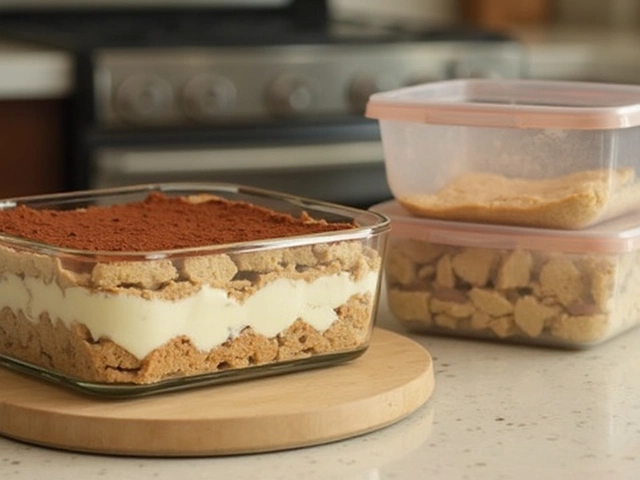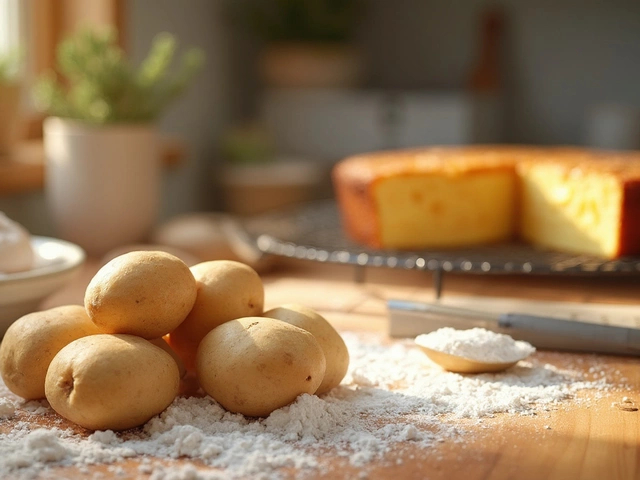
Ever read a cake recipe and stopped dead at the word 'flour' because gluten is off-limits? Yep, that used to stress me out too. Thing is, not all flours are created equal—especially if you can't touch gluten. Knowing which flours are safe opens up a whole new world of baking, cakes included.
Sticking with wheat flour is out of the question for anyone with celiac or gluten intolerance. But here’s the good news: there are plenty of gluten-free flours you can use for cakes, and some of them actually taste great. The trick is finding what works and knowing what to avoid, so you don’t end up with a dense brick or weird aftertaste.
Let’s break it down—the flours that are gluten-free, how they function in cake recipes, and the sneaky troubles you might run into. When you know what to look for (and what to avoid), gluten-free cakes are suddenly a whole lot less scary. Ready to pick the right flour and actually enjoy your next bake?
- What Actually Is Gluten-Free Flour?
- Top Gluten-Free Flours for Cakes
- How Flours Behave When Baking Cakes
- Mixing and Matching for Better Texture
- Common Problems and Easy Fixes
- Allergy Warnings and Smart Label Reading
What Actually Is Gluten-Free Flour?
Think of gluten-free flour as flour that never started with wheat, barley, or rye—basically anything that could bring gluten to the party. Gluten is a protein that gives regular dough its stretchy feel and chewy bite. Take it out, and you need to replace it with something that can still bake up soft, fluffy, and tasty. That’s what a gluten-free flour tries to do: step in where wheat flour can’t go.
The most common gluten-free flours are made from grains and plants that are already gluten-free by nature. Here are the heavy hitters you’ll find on shelves:
- Rice flour: Mild, fine, and super cheap. Great base for blends but can be gritty alone.
- Almond flour: Slightly sweet and moist, made from ground almonds. Nice for dense or moist cakes.
- Coconut flour: Absorbs a ton of moisture—needs extra eggs or liquid, or it will suck your batter dry.
- Sorghum flour: Neutral flavor and works well in mixes. Less common but pretty handy.
- Oat flour: As long as it’s labeled gluten-free—cross-contamination is huge otherwise. Adds softness.
- Tapioca and potato starch: Not exactly flour, but these lighten up blends and give cakes that bounce. Use with others.
And it turns out most store-bought gluten-free flour blends are just a mix of several of these, often with a binding agent like xanthan gum to mimic what gluten does.
Glossary time! Here’s a little cheat sheet to some top gluten-free options and what makes them special:
| Flour Type | Main Ingredient | Good For | Watch Out For |
|---|---|---|---|
| Rice Flour | White or brown rice | Base in cake blends | Gritty textures if used alone |
| Almond Flour | Ground almonds | Moist cakes, brownies | Nut allergies, heavy if overused |
| Coconut Flour | Coconut meat | Low-carb cakes | Needs lots of liquid/eggs |
| Oat Flour | Oats | Soft, tender crumb | Buy certified gluten-free only |
| Sorghum Flour | Sorghum grain | Mixed use, mild flavor | Rare on shelves |
| Tapioca Starch | Root vegetable (cassava) | Adds springiness | Not for use alone |
Stick with labeled, certified gluten-free bags. Some flours get contaminated during processing—especially oat, corn, and bean flours. Check that label every time. If you bake for others, always ask if they’re okay with nuts—that’s a common ingredient in almond and some store-bought blends.
Top Gluten-Free Flours for Cakes
So, you’re shopping for gluten-free flour and the options look endless. But honestly, not all of them work for cakes. Some are best for bread, others are fine for cookies, and a few are just too gritty or strong-tasting for something delicate like cake. Here are the top picks that most folks and even bakeries swear by for making tasty, soft cakes without gluten:
- Rice Flour: The most common gluten-free option. White rice flour is light and pretty neutral, which helps cakes stay soft. But if you go with brown rice flour, you’ll get a slight nutty flavor and a tiny bit more fiber.
- Almond Flour: Adds a really nice moist texture and subtle sweetness. Great for denser cakes or adding richness. The only catch: it’s not nut-safe if you have allergies at home.
- Sorghum Flour: Mild in flavor but helps balance the texture. Sorghum flour is used in a lot of classic gluten-free cake recipes when you want a light crumb instead of a rubbery loaf.
- Coconut Flour: Super absorbent, so you need much less of it and extra eggs or liquid. It’s perfect for folks who love a faint coconut taste in their goodies.
- Oat Flour: If you’re fine with properly labeled "gluten-free" oats, this flour is a winner for softness and fiber. It gives cakes a bit of chew you just don’t get from plain rice flour.
- Potato Starch/Tapioca Starch: These are almost always blended with other flours. They make cakes lighter and fluffier—think of them as the secret behind a good crumb.
It’s super common to use at least two or three of these at once. Most gluten-free all-purpose blends are actually a mix of rice flour, potato starch, and tapioca starch—sometimes with xanthan gum to help the cake hold together.
Here’s a quick look at how some of these options stack up in cakes:
| Flour Type | Texture in Cakes | Main Flavor Notes | Special Notes |
|---|---|---|---|
| Rice Flour (white) | Soft, tender | Neutral, bland | Best in blends, not alone |
| Almond Flour | Moist, rich, dense | Nutty, sweet | Good for brownies or carrot cake |
| Sorghum Flour | Light, fluffy | Mild, earthy | Pair with neutral starches |
| Coconut Flour | Spongy, dry if overused | Coconut | Needs more liquid and eggs |
| Oat Flour | Soft, slightly chewy | Mild, oaty | Must be labeled gluten-free |
Pro tip: Always check that store-bought blends are certified gluten-free. Cross-contamination is real, even if the main ingredient is naturally gluten-free. If you notice a cake recipe calls for a specific blend, try to stick with it—swapping in something totally different can change the whole texture.
If you want super-basic, use a store-bought gluten-free all-purpose mix for your first few cakes and then experiment from there. Even professional gluten-free bakeries use blends—there's no shame in making it easier for yourself.
How Flours Behave When Baking Cakes
Gluten-free flours don’t act the same way as regular wheat flour, which makes baking cakes a little tricky if you’re doing it for the first time. What’s missing is gluten—a stretchy protein that helps trap air and gives cakes their bounce. Take away gluten and the rules change fast.
Rice flour, for example, is a popular choice, but it can leave cakes a little dry or gritty if you use it on its own. Almond flour brings a rich flavor and keeps things moist, but the cake can turn out dense if you go overboard. Tapioca and potato starches help with that light, fluffy texture but don’t bring much flavor by themselves. That’s why most gluten-free cake recipes mix two or more flours to get the right balance.
Check out how some common gluten-free flours stack up:
| Flour | Texture | Moisture | Flavor |
|---|---|---|---|
| Rice Flour | Fine, but slightly gritty | Dries quickly | Neutral |
| Almond Flour | Dense, tender | Very moist | Nutty |
| Coconut Flour | Fine, crumbly | Absorbs lots of liquid | Coconut |
| Sorghum Flour | Soft, cake-like | Balanced | Mildly sweet |
| Potato/Tapioca Starch | Light, fluffy | Adds moisture | Bland |
Baking with gluten-free flour usually means your batter will look a bit runnier or thicker than a wheat-based recipe, so don’t panic if it seems off. It’s normal. Make sure to measure your flours carefully—too much coconut flour can turn a cake into a sponge, and too much potato starch makes for a gummy bite.
Pro tip: Gluten-free cakes almost always need some kind of binder, like xanthan gum or eggs, just to keep everything together. Don’t skip this step, or your cake could crumble apart right out of the pan (yep, I’ve done that).
If you want to test which combo works best for your taste, bake a few cupcakes using different flours or blends. It’s a small batch, so you don’t waste a whole cake if it flops. Each flour brings its own personality to the cake—so experiment and see what feels (and tastes) right for you.

Mixing and Matching for Better Texture
Ever noticed that just swapping in one gluten-free flour often leads to crumbly, gritty, or heavy cakes? You’re not imagining things. A lot of gluten-free flours work better in combos than on their own. Why? Because wheat flour is kind of a superstar—it brings structure and moistness—and no single gluten-free flour can pull off every task by itself.
Mixing flours spreads out their strengths and weaknesses. For cakes, a common trick is to use a blend of a starch (like tapioca or potato), a grain or seed flour (such as brown rice or sorghum), and sometimes a nut flour (like almond). The starch helps lighten the crumb, the grain gives bulk, and a bit of nut flour adds moisture that gluten-free cakes seriously need.
Here’s a basic starter mix you can try for cake recipes:
- 1 cup rice flour (brown or white, up to you)
- 1/3 cup potato starch or tapioca starch
- 1/4 cup almond flour
Give this combo a whirl instead of straight-up one flour. If nut allergies are a problem, swap out almond with more rice or add sorghum. Some gluten-free bakers swear by adding just a teaspoon of xanthan gum or psyllium husk per cup of flour mix—it helps give cakes some stretch and hold so they don’t crumble when you slice them.
Here are a few tested tips to keep in mind:
- Don’t just sub out cup-for-cup if your recipe calls for all-purpose wheat flour. Gluten-free blends tend to soak up more liquid, so you’ll probably need more eggs or a splash more liquid.
- Sift your flour blend before using. Clumpy flour means uneven texture, and sifting helps give cakes a fluffier bite.
- Read labels carefully—sometimes even flour marked 'gluten-free' is processed in places that handle wheat. Cross-contamination is sneaky and real.
Every brand and mix can act a little differently, so you’ll find yourself tweaking recipes to get your perfect texture. Keep notes as you go—your future self (and your taste buds) will thank you. And remember, if your first attempt is a bit dense, it doesn’t mean you failed. Adjust your ratios, keep experimenting with your gluten-free flour choices, and you’ll find what works best.
Common Problems and Easy Fixes
Baking a cake with gluten-free flour can throw some curveballs your way. If you’re used to regular wheat flour, the first gluten-free cake you bake might turn out dry, crumbly, or just plain flat. But don’t panic—most of these problems have simple fixes.
Here are some of the most common issues and how to handle them:
- Cakes Are Dry or Crumbly: Gluten usually keeps cakes moist and holds everything together. Try adding a tablespoon of applesauce, yogurt, or even a splash of milk to your batter. Using a blend of gluten-free flours (like rice, potato, and tapioca together) instead of just one also helps with texture.
- Cakes Won’t Rise: Without gluten, it’s tough to trap air and get that nice lift. Make sure you’re using fresh baking powder or baking soda, and try adding an extra egg for more structure. Xanthan gum or guar gum (about 1/2 teaspoon per cup of flour) acts as a stand-in for gluten and really helps here.
- Gritty Texture: Rice flour is often to blame for a sandy bite. Switch to superfine rice flour or mix in some starches like cornstarch or potato starch. Letting your batter rest for 10-15 minutes before baking can also soak up the grittiness.
- Strange Flavor or Aftertaste: Some gluten-free flours—sorghum, quinoa, or buckwheat—have strong flavors that can overwhelm your cake. Balance it out with vanilla extract, citrus zest, or a bit of cocoa powder. If a mix tastes off, try a different brand or blend next time.
- Cakes Sticking to the Pan: Gluten-free cakes are more fragile. Always line your pans with parchment paper and grease them well. Let the cake cool before flipping it out—patience actually saves cakes here.
If you’re just starting out, using a store-bought gluten-free flour blend is less risky than DIY mixes. And hey, even when cakes flop, leftover scraps make great cake pops—Whiskers approves of any kitchen fun, but I’d keep the chocolate away from curious pets.
Allergy Warnings and Smart Label Reading
Navigating the gluten-free baking aisle isn't just about dodging gluten. Lots of these flours come from seeds, nuts, or grains that can cause allergies, so checking labels becomes almost like a sport. Gluten-free flour blends might seem safe, but cross-contamination in factories is a real thing. In the U.S., a package labeled “gluten-free” is supposed to have less than 20 parts per million (ppm) of gluten, but not all brands get it right every time.
Here’s what to look for when you’re staring at those bags of flour at the store:
- Allergen statements: These usually appear near the ingredient list. Watch for warnings about peanuts, tree nuts, soy, or dairy. For example, almond flour and coconut flour both come from tree nuts.
- “Made in a facility” warnings: Even if the flour itself is gluten-free, it could be processed on the same lines as wheat. Look for “dedicated gluten-free facility” on the label if you’re highly sensitive.
- Ingredient lists: Some gluten-free flour mixes sneak in other potential allergens like milk powder or soy lecithin. Always check the full ingredient panel, especially if baking for a group with mixed food allergies.
- Certification logos: Third-party certifications (like the GFCO or CSA seal) mean the flour met a higher standard in testing for gluten content.
If you’re super cautious or baking for someone else, jot down which brands you trust—and maybe even snap a phone pic of the label so you can double-check stuff later. Whiskers chewed on my shopping list once, so I go digital now!
Here’s a quick rundown of common gluten-free flours and possible allergens to watch for:
| Flour Type | Common Allergens | Tips for Use |
|---|---|---|
| Almond flour | Tree nuts | Avoid if nut allergies; buy from dedicated facilities. |
| Coconut flour | Tree nuts (some debate if coconut is a true nut, but many labels treat it that way) | Check labels; use with extra moisture. |
| Soy flour | Soy | Rare in cake recipes, but possible; avoid with soy allergies. |
| Oat flour | Possible gluten cross-contact; sometimes labeled “may contain gluten” | Look for certified gluten-free oats/flour. |
| Chickpea flour | Legumes | Can be cross-contaminated with wheat; check packaging. |
Before you head home, double-check the bag one more time. Manufacturers update their equipment or ingredient sources now and then, so what was safe a month ago might have changed. If in doubt, call the brand’s customer support—usually, they’ll answer allergy questions faster than you’d expect. No cake is worth a trip to the ER, right?





